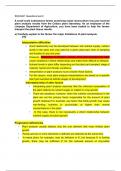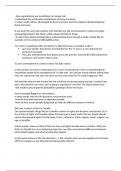Astronomical unit (AU) = 1.496x1011 (centre of sun to centre of Earth)
Parsec (pc) : Distance to a star which subtends the angle of 1pc to the line form the centre of
the Earth to the centre of the Sun
SI for star distance as such awkward numbers
Converging
Makes parallel rays bend towards
Beyond Focus
Real image where light rays meet on screen
Object closer to focus, screen further back for clear image
Object closer to lens, larger image
Closer than focus
Magnified image formed as lens acts as magnifying glass
Virtual image (only be seen when viewed from other side of lens)
Ray Diagrams
f: focal length u: object distance
1/f = 1/u + 1/v
Formation of a real image
u>f therefore image formed on other side of lens
All start at top of object
1- Parallel to PA then refracted through F
2- Through PF, no change
3- Through F then refracted to be parallel to PA
Real image formed at intersection of the lines
Formation of a Virtual Image
u<f therefore image magnified on same side as object
1- Parallel to PA then refracted through focus
2- Through PF, no change
3- Draw dotted lines back until the two converge
Enlarged virtual image formed behind object
REFRACTING TELESCOPE
Two converging lenses of different focal lengths
Fo>Fe for enlargement
‘Objective’ : lens (longer f) faces object
Eyepiece : lens (shorter f) used as eyepiece
Alter distance between the two to bring object
into focus
Distant object (star) : Enlarged, virtual, inverted image
Normal adjustment: distance between the two lenses,
sum of their focal lengths
,Objective Lens
Focus rays to form a real image
Real image of distant object formed in FP
Eyepiece lens
Magnified view - virtual image from infinity
1. Light rays from object are (effectively) parallel and leave telescope as a parallel beam
therefore makes it seem like a distant point
2. Real image is inverted and diminished; therefore eyepiece is roughly a magnifying glass,
same orientation as real image therefore inverted to object
3. Final direction of rays given by construction line from tip of image through centre of
eyepiece
a: angle to object b: angle to image
Angular magnification: How many times
bigger image is than object
H1, : Height of real image
tan(a) = h1/fo tan(b) = h1/fe
h1 = fo tan = foa
Angular Magnification: fo/fe
Collecting Power
Collecting Power: (objective diameter2)
amount of light a telescope collects
Stars get brighter through telescope as
objective lens is bigger than eye so more
light enters
Pupil in darkness ≈ 10mm so diameter of
60mm = (60/10)2 = 36x more
Planets Magnified Using a Telescope
Not significantly brighter as virtual image is magnified so spread out over a larger area
Stars are point objects so point images
REFLECTING TELESCOPES
Concave mirror as a primary mirror
Secondary smaller mirror as a concave reflector
Forms a real image of a distant object
Cassegrain Reflecting Telescope
2nd mirror is convex between the concave and its focal point
To focus light onto/behind small hole at the centre of concave mirror
Then passes through eyepiece making a virtual image at infinity
Primary mirror should be parabolic rather than spherical to minimize
spherical aberration
Spherical aberration - less defined as outer rays would focus sooner than inner ones
, COMPARISON OF REFRACTORS AND REFLECTORS
Reflecting
Can be wider so greater collecting power
Wide concave objective as - less image distortion due to spherical aberration
- Unwanted colours reduced (refraction)
chromatic aberration: causes images to be tinted, especially at the edges
Blue nearer to the mirror then red as refracted more
Shorter telescope for same angular magnification and produces greater overall magnification
Refracting
Lenses only, doesn’t block any light
Wider field of view, less angular magnification, easier to locate objects
Angular Resolution
Extent of detail depends on width of objective
Light defracts more through a smaller hole
Diffraction causes it to spread, not remain a point object
The narrower the objective means the greater the diffraction and the greater the spread
Resolving Two Stars
Rayleigh Criterion : If any part of the central spot lies within the first dark ring of the other star
then the two cannot be resolved
Θ roughly = λ / D //// Θ ≈ c/f / d
Θ angular separation resolution ≥ angle of diffraction of the first dark ring
Minimum angular resolution (resolving power)
Describes quality of a telescope in terms of the θ it can do
RC applies to the detail visible in images as refraction caused by air in the atmosphere causes
smudged images
Ground telescopes with objectives >1m diameter don’t achieve their stated resolution
TELESCOPES AND TECHNOLOGY
CCD - charged coupled device
Extended range of objects that can be seen as high-quality images
Light sensitive pixels charged when exposed to light
Exposed for pre-set time then connected to circuit
Transfers charge from each pixel to output electrode connected to a capacitor
Voltage of output electrode read electronically
Capacitor discharged before next pulse
Output electrode produces a stream of voltage pulses
Each one of amplitude proportional to the light energy received by individual pixels
Pulses stored and create a visual image on a flat panelled screen
Quantum Efficiency of a Pixel: Percentage of incident photons that free an electron
Quantum Efficiency: Eye 1 or 2%, CCD 70%
Grain of photographic film have about 4% (1/25 contribute) to the darkening of each grain
Resolution depends on the pixel size, ≈ 10μm
Light sensitive receptor cells in the eyes are 5μm but not evenly distributed
2 star images must be separated by 1 or more un-illuminated pixels to be seen separately
Parsec (pc) : Distance to a star which subtends the angle of 1pc to the line form the centre of
the Earth to the centre of the Sun
SI for star distance as such awkward numbers
Converging
Makes parallel rays bend towards
Beyond Focus
Real image where light rays meet on screen
Object closer to focus, screen further back for clear image
Object closer to lens, larger image
Closer than focus
Magnified image formed as lens acts as magnifying glass
Virtual image (only be seen when viewed from other side of lens)
Ray Diagrams
f: focal length u: object distance
1/f = 1/u + 1/v
Formation of a real image
u>f therefore image formed on other side of lens
All start at top of object
1- Parallel to PA then refracted through F
2- Through PF, no change
3- Through F then refracted to be parallel to PA
Real image formed at intersection of the lines
Formation of a Virtual Image
u<f therefore image magnified on same side as object
1- Parallel to PA then refracted through focus
2- Through PF, no change
3- Draw dotted lines back until the two converge
Enlarged virtual image formed behind object
REFRACTING TELESCOPE
Two converging lenses of different focal lengths
Fo>Fe for enlargement
‘Objective’ : lens (longer f) faces object
Eyepiece : lens (shorter f) used as eyepiece
Alter distance between the two to bring object
into focus
Distant object (star) : Enlarged, virtual, inverted image
Normal adjustment: distance between the two lenses,
sum of their focal lengths
,Objective Lens
Focus rays to form a real image
Real image of distant object formed in FP
Eyepiece lens
Magnified view - virtual image from infinity
1. Light rays from object are (effectively) parallel and leave telescope as a parallel beam
therefore makes it seem like a distant point
2. Real image is inverted and diminished; therefore eyepiece is roughly a magnifying glass,
same orientation as real image therefore inverted to object
3. Final direction of rays given by construction line from tip of image through centre of
eyepiece
a: angle to object b: angle to image
Angular magnification: How many times
bigger image is than object
H1, : Height of real image
tan(a) = h1/fo tan(b) = h1/fe
h1 = fo tan = foa
Angular Magnification: fo/fe
Collecting Power
Collecting Power: (objective diameter2)
amount of light a telescope collects
Stars get brighter through telescope as
objective lens is bigger than eye so more
light enters
Pupil in darkness ≈ 10mm so diameter of
60mm = (60/10)2 = 36x more
Planets Magnified Using a Telescope
Not significantly brighter as virtual image is magnified so spread out over a larger area
Stars are point objects so point images
REFLECTING TELESCOPES
Concave mirror as a primary mirror
Secondary smaller mirror as a concave reflector
Forms a real image of a distant object
Cassegrain Reflecting Telescope
2nd mirror is convex between the concave and its focal point
To focus light onto/behind small hole at the centre of concave mirror
Then passes through eyepiece making a virtual image at infinity
Primary mirror should be parabolic rather than spherical to minimize
spherical aberration
Spherical aberration - less defined as outer rays would focus sooner than inner ones
, COMPARISON OF REFRACTORS AND REFLECTORS
Reflecting
Can be wider so greater collecting power
Wide concave objective as - less image distortion due to spherical aberration
- Unwanted colours reduced (refraction)
chromatic aberration: causes images to be tinted, especially at the edges
Blue nearer to the mirror then red as refracted more
Shorter telescope for same angular magnification and produces greater overall magnification
Refracting
Lenses only, doesn’t block any light
Wider field of view, less angular magnification, easier to locate objects
Angular Resolution
Extent of detail depends on width of objective
Light defracts more through a smaller hole
Diffraction causes it to spread, not remain a point object
The narrower the objective means the greater the diffraction and the greater the spread
Resolving Two Stars
Rayleigh Criterion : If any part of the central spot lies within the first dark ring of the other star
then the two cannot be resolved
Θ roughly = λ / D //// Θ ≈ c/f / d
Θ angular separation resolution ≥ angle of diffraction of the first dark ring
Minimum angular resolution (resolving power)
Describes quality of a telescope in terms of the θ it can do
RC applies to the detail visible in images as refraction caused by air in the atmosphere causes
smudged images
Ground telescopes with objectives >1m diameter don’t achieve their stated resolution
TELESCOPES AND TECHNOLOGY
CCD - charged coupled device
Extended range of objects that can be seen as high-quality images
Light sensitive pixels charged when exposed to light
Exposed for pre-set time then connected to circuit
Transfers charge from each pixel to output electrode connected to a capacitor
Voltage of output electrode read electronically
Capacitor discharged before next pulse
Output electrode produces a stream of voltage pulses
Each one of amplitude proportional to the light energy received by individual pixels
Pulses stored and create a visual image on a flat panelled screen
Quantum Efficiency of a Pixel: Percentage of incident photons that free an electron
Quantum Efficiency: Eye 1 or 2%, CCD 70%
Grain of photographic film have about 4% (1/25 contribute) to the darkening of each grain
Resolution depends on the pixel size, ≈ 10μm
Light sensitive receptor cells in the eyes are 5μm but not evenly distributed
2 star images must be separated by 1 or more un-illuminated pixels to be seen separately




